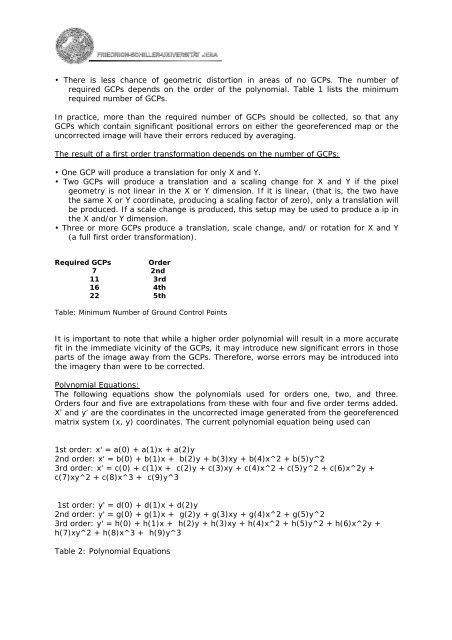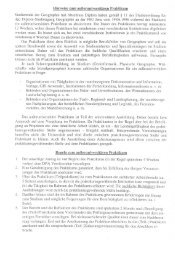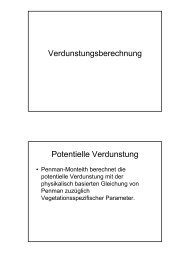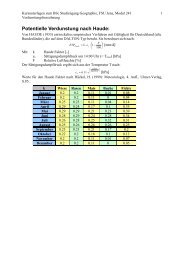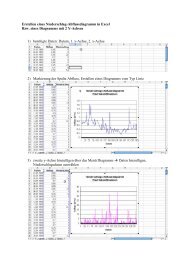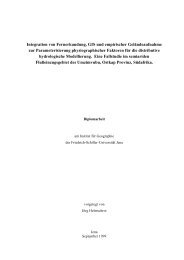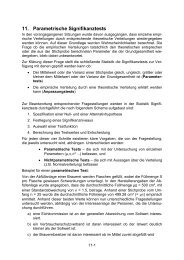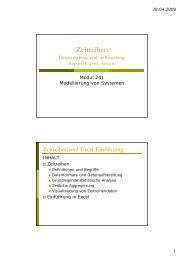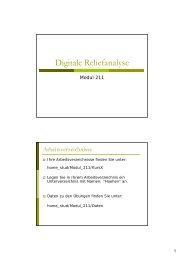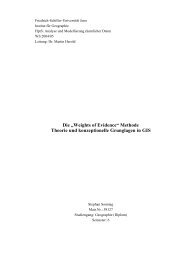Fernerkundung I (Digitale Bildverarbeitung) - Friedrich-Schiller ...
Fernerkundung I (Digitale Bildverarbeitung) - Friedrich-Schiller ...
Fernerkundung I (Digitale Bildverarbeitung) - Friedrich-Schiller ...
You also want an ePaper? Increase the reach of your titles
YUMPU automatically turns print PDFs into web optimized ePapers that Google loves.
• There is less chance of geometric distortion in areas of no GCPs. The number of<br />
required GCPs depends on the order of the polynomial. Table 1 lists the minimum<br />
required number of GCPs.<br />
In practice, more than the required number of GCPs should be collected, so that any<br />
GCPs which contain significant positional errors on either the georeferenced map or the<br />
uncorrected image will have their errors reduced by averaging.<br />
The result of a first order transformation depends on the number of GCPs:<br />
• One GCP will produce a translation for only X and Y.<br />
• Two GCPs will produce a translation and a scaling change for X and Y if the pixel<br />
geometry is not linear in the X or Y dimension. If it is linear, (that is, the two have<br />
the same X or Y coordinate, producing a scaling factor of zero), only a translation will<br />
be produced. If a scale change is produced, this setup may be used to produce a ip in<br />
the X and/or Y dimension.<br />
• Three or more GCPs produce a translation, scale change, and/ or rotation for X and Y<br />
(a full first order transformation).<br />
Required GCPs<br />
Order<br />
7 2nd<br />
11 3rd<br />
16 4th<br />
22 5th<br />
Table: Minimum Number of Ground Control Points<br />
Required GCPs Order<br />
It is important to note that while a higher order polynomial will result in a more accurate<br />
fit in the immediate vicinity of the GCPs, it may introduce new significant errors in those<br />
parts of the image away from the GCPs. Therefore, worse errors may be introduced into<br />
the imagery than were to be corrected.<br />
Polynomial Equations:<br />
The following equations show the polynomials used for orders one, two, and three.<br />
Orders four and five are extrapolations from these with four and five order terms added.<br />
X’ and y’ are the coordinates in the uncorrected image generated from the georeferenced<br />
matrix system (x, y) coordinates. The current polynomial equation being used can<br />
1st order: x' = a(0) + a(1)x + a(2)y<br />
2nd order: x' = b(0) + b(1)x + b(2)y + b(3)xy + b(4)x^2 + b(5)y^2<br />
3rd order: x' = c(0) + c(1)x + c(2)y + c(3)xy + c(4)x^2 + c(5)y^2 + c(6)x^2y +<br />
c(7)xy^2 + c(8)x^3 + c(9)y^3<br />
1st order: y' = d(0) + d(1)x + d(2)y<br />
2nd order: y' = g(0) + g(1)x + g(2)y + g(3)xy + g(4)x^2 + g(5)y^2<br />
3rd order: y' = h(0) + h(1)x + h(2)y + h(3)xy + h(4)x^2 + h(5)y^2 + h(6)x^2y +<br />
h(7)xy^2 + h(8)x^3 + h(9)y^3<br />
Table 2: Polynomial Equations<br />
Order Equation


